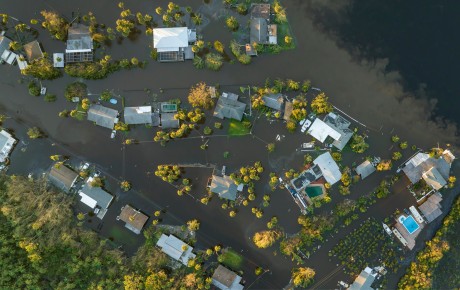
How going digital can bring better flood protection for small US businesses
According to recent research from the U.S. Chamber of Commerce, one in four (27%) small businesses in the US say they are one disaster or threat away from closing and, of those potential business destroying disasters, flood is increasingly posing a challenge with the frequency and severity of incidents rising in many areas. The US National Flood Insurance Program (NFIP) estimates that retail, office and multi-unit residential properties lost more than US $13.5 billion in 2022 from flood damage.
These losses mean that building better flood resilience and disaster preparedness must be a key objective for every small business; an approach that should have effective flood insurance at its core. Unfortunately, little more than a third (38%) of small businesses buy insurance to cover themselves from potential losses related to natural disasters like flood, reports the U.S. Chamber of Commerce. “There is a significant majority of small businesses in the US who don’t buy flood insurance,” says Hiscox’s Daniel Simmonds, Senior Flood Underwriter, “which is leaving many of them exposed to balance sheet busting flood events. Digital transformation, however, is helping to address this problem by making it easier to access and buy flood insurance products from the private market, ensuring that small businesses benefit from better, tailored coverage at competitive risk premiums.”
Awareness
Why the number of small US businesses buying flood insurance is low can be put down to several factors such as low awareness of the risk, access problems in finding the right cover, and price. Awareness has long been a problem particularly for businesses based in inland areas which have historically not been as flood prone compared to coastal regions. But that awareness is beginning to change says Colby Guillory, Underwriter for Sterling Surplus Underwriters – one of Hiscox’s coverholders selling flood insurance in the US: “Commercial insurance customers are starting to understand flood coverage is important due to the catastrophic events of torrential rain and hurricane events throughout the US.” And many more are seeing that flood risk can now be anywhere, adds Guillory, with around 40% of all NFIP losses in what have been previously categorised as low risk or moderate risk flood zones.
Access problems
Another problematic factor has been ready access to insurance flood products through local retail agents. “If a business is coastal, they can go to their local retail agency for flood insurance, and they're more than likely going to be taken care of because the agency has experience in flood,” says Guillory. “Whereas, if they're inland, the agency they use may not have flood insurance expertise simply because they have not historically written that type of business and may also only be aware of what the NFIP offers as opposed to the private flood insurance market.”
That means it’s important for the private flood insurance industry to work closely to remove some of these obstacles on the buying journey for flood cover, which is where digital has a critical role to play. “In the world we live in where everything is digital and you can buy anything on your phone, or on your computer, and get answers within seconds, the insurance marketplace shouldn't be any different,” says Guillory. “The ability to provide a quoting portal where retail agents can get quotes for flood insurance within seconds, and which binds cover within minutes, helps to make the buying journey for agents and their clients much easier. The agent is also protecting themselves by offering flood cover from an E&O standpoint by making sure the insured gets a flood quote and is given the option to purchase.”
The price must be right
Pricing is another potential obstacle to purchasing flood insurance that the digital transformation is helping to address. “The more accurate data we get and collect through our digital platform, the more competitive and proactive we can be on pricing,” says Hiscox’s Simmonds. “We are not going to say you are in this particular US state, so we've just got a flat price. It's now much more granular than that which helps customers understand they are getting the best possible price for their exact location and gives coverholders like Sterling a better chance of binding cover.” In the pre-digital era, it might have taken months to adjust pricing, Simmonds adds, whereas that process can now happen in a few days with the real time effect of data collection providing a genuine competitive edge for the benefit of insureds.
Attractive cover
Along with accurate pricing, a digital approach also means the private flood insurance market can effectively use data to provide cover that is more attractive to that available from the NFIP. “Having more robust coverage, offering higher limits greater than NFIP, along with business income insurance, are key points that the insured values if it's at the right price,” says Guillory. In addition, says Simmonds, cover through digital products such as Hiscox’s own FloodPlus Commercial offering can be bound within seven days as opposed to the usual 30 day wait: "Access to real-time data allows us to provide additional benefits to customers, such as higher limits for building and business personal property, as well as competitive and scalable business interruption coverage. This capability enables us to process thousands of quotes per day."
Lowering the barriers
With the growing likelihood of increasingly frequent and severe flooding events, small businesses in the US regardless of whether they are based in coastal regions or inland, will need a healthy and competitive private flood insurance market. A digital approach will be fundamental in delivering that market, says Simmonds: “The digital transformation is already lowering the barriers in the journey towards more competitive and comprehensive flood insurance cover for small businesses. Expect that progress to continue at pace as stakeholders all along the insurance value chain, from insurers, through to coverholders, and agents, harness digital innovation to help small businesses mitigate the risk of flood to their livelihoods.”




